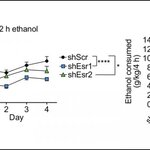Genetics & Molecular Biology

Humans each have 23 pairs of chromosomes, the 23rd of which determines sex. Females carry two X sex chromosomes, males carry one X and one Y chromosome. Yet this male chromosome carries genes that females lack and those male genes are expressed in all cells of the body, but their only confirmed role has been limited determining male or female.
A new study on a little-known role of Y chromosome genes, specific to males, could explain why men suffer differently than women from various diseases, including Covid-19. Males differ from females in the manifestation, severity and consequences of…

In the old days, if you wanted to spread desirable characteristics in livestock you had to try breeding and hope for the best. The 19th century breakthroughs in genetics promised a future where trial and error was no longer the norm.
Now, with desire to optimize food production and reduce environmental impact without harming choices for poor people, scientists have created pigs, goats and cattle that can serve as viable “surrogate sires” - male animals that produce sperm carrying only the genetic traits of donor animals.
This will allow more precision breeding in animals such as goats, where…

Using the genome-editing technology CRISPR, researchers can make targeted cuts to the genome or insert useful genes, called a gene knock-in, and they have done it with the cattle SRY gene, responsible for initiating male development, into a bovine embryo.
This first demonstration of a targeted gene knock-in for large sequences of DNA via embryo-mediated genome editing in cattle will mean it produces male offspring 75 percent of the time.
That's not to increase sexism, it's a benefit because male cattle are about 15 percent more efficient at converting feed into weight gain than females…

Humans do not hibernate, but in science-fiction films long-distance travel often involves "suspended animation" where muscular atrophy, starvation, and oxygen deprivation don't occur.
Mice don't hibernate either but they just did in experiments. Mice are obviously not little people, that is why claims involving mice are in the exploratory camp, but animals models are often a waypoint on the path to humans.
Animals usually enter hibernation when food becomes scarce in the winter. Their metabolism slows down, and their body temperature drops to a new set-point. This is like lowering…

A new paper posits that fluctuating estrogen levels may make alcohol more rewarding.
The giant caveat is that the study was in mice, and despite what you may read in corporate media, mice are not little people, so this research is firmly in the "exploratory" part of science.
One thing is sure; most people can engage in recreational use of alcohol but some cannot. There is no settled reason for the distinction and some camps blame impulse control while others note that alcohol is a real carcinogen, and not the modern weird claims from IARC like hot tea and weedkillers are because a…

A new paper suggests 47 links between our genetic code and the quality, quantity and timing of our sleep.
The correlation was created using 85,670 participants of UK Biobank and 5,819 individuals from three other studies, who wore accelerometers (e.g. Fitbit) which recorded activity levels continuously. They wore the accelerometers continuously for seven days which provides more accuracy than people who write how well they slept diaries. . The authors created ten new genetic links with sleep duration and 26 with sleep quality. Among the genomic regions uncovered is a gene called…

A recent study identified the coronavirus responsible for the pneumonia epidemic in the Hubei province of China and finds the bat-origin virus is related to other known pathogenic coronaviruses.
The 2019 coronavirus (CoV) causes fatal pneumonia that has claimed over 1,300 lives, with more than 52,000 confirmed cases of infection by mid-February, along with various impacts to the lives of the scholars who revealed the virus against the wishes of the Chinese government.
In early December, a few people in the city of Wuhan in the Hubei province of China became ill after going to a local…

Everyone has heard of the
nutrient, nitrogen, but why
is it important to plants?
It's a key ingredient in proteins, both in the
grains (seeds) we eat and in leaves. Nitrogen-starved
leaves may turn yellow and have lower rates of [1] photosynthesis,
which turns carbon dioxide from the atmosphere into new plant growth.
To
keep food affordable and protect the environment, crop plants need just the
right amount of nitrogen, but this is a challenge for both farmers and
scientists. Too much nitrogen fertilizer
on crops pollutes rivers and well water and its cost makes food
more…

Plutella xylostella (diamondback moth) does tremendous damage to brassica crops such as cabbage, broccoli, cauliflower and canola. A new strain of diamondback moth developed by Oxitec Ltd, (OX4319L) is modified to control pest diamondback moth in a targeted manner. It limits its pest counterparts because they find and mate with pest females, but they pass along a self-limiting gene to offspring, which prevents female caterpillars from surviving.
With sustained releases, the pest population is suppressed in a targeted, ecologically sustainable way. After releases stop, the self-limiting…

The Civil Defense Caves in Dubois, Idaho, utilized as potential fallout shelters during the Cold War, are actually ancient lava tubes. Since they are easily accessible caves they have become popular family treks. In August of 1979, one such trek had a family hunting for arrowheads who instead found a headless male torso wrapped in burlap. The only clue was a dark red sweater.
A decade later, a youngster exploring the same cave found two arms and two legs, also wrapped in burlap. Naturally, the search began for a head but no luck.
The "Buffalo Cave Torso" went to the FBI and then the…